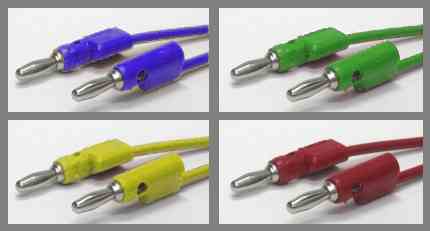



In the context of electroanalytical chemistry, the terms cathode, cathodic current, and reduction are closely related.
A cathodic current is the flow of electrical charge (usually carried by electrons) out of a working electrode into a second phase (usually an electrolyte solution) leading to the reduction of one or more species in the second phase.
As an example, consider a platinum working electrode immersed in an acidic solution of iron(III) chloride. If the platinum working electrode is poised at a sufficiently negative potential, any iron(III) cations in the vicinity of the electrode surface will gain an electron and be reduced to iron(II) cations according to the following half reaction:
In this case, the flow of electrons out of the working electrode as a result of the reduction of the iron(III) cations is a cathodic current.
Related Terms: cathode, reduction
Antonyms: anodic current

Typical Banana Cables
(terminated with stackable banana connectors)
Banana connectors are commonly used to make simple and quick connections between scientific instruments. Patch cables terminated with banana plugs (male) fit into banana jacks (female) on instrument panels. The conductive metal portion of the banana plug is about an inch long and bulges slightly to provide a secure mechanical fit when inserted into a banana jack.
Some banana connectors are stackable, having both a plug and jack integrated into the same connector. Such stackable connectors allow multiple banana cables to be rapidly shorted together in the same banana jack.
Related Terms: banana cable
In the context of electroanalytical chemistry, the terms anode, anodic current, and oxidation are closely related.
An anodic current is the flow of electrical charge (usually carried by electrons) into a working electrode from a second phase (usually an electrolyte solution) as a result of the oxidation of one or more species in the second phase.
As an example, consider a platinum working electrode immersed in an acidic solution of iron(II) chloride. If the platinum working electrode is poised at a sufficiently positive potential, any iron(II) cations in the vicinity of the electrode surface will lose an electron and be oxidized to iron(III) cations according to the following half reaction:
In this case, the flow of electrons into the working electrode as a result of the oxidation of the iron(II) cations is an anodic current.
Related Terms: anode, oxidation
Antonyms: cathodic current
Many of the more advanced controls for your personal computer are located on the Windows Control Panel. The location and appearance of the Windows Control panel often changes which each release of the Windows Operating System. This article describes how to find the Control Panel on a standard Microsoft Windows XP system.
The Windows Device Manager allows you to visualize the status of all the various hardware components of your personal computer or laptop. The Device Manager maintains a list of all active hardware devices, sorted by category.
The main view offered by the Device Manager is a list of all of the hardware components installed in your computer. This list is organized into various catagories, and each computer will have a unique list depending upon which devices are installed. Examples from two different computers are shown below.
These days, your personal computer's operating system is in a constant state of flux. Patches, security fixes, and enhanced features are added to the operating system frequently. To keep your system up to date and secure, it is a good idea to periodically run the Windows Update utility and download the latest and greatest fixes for Microsoft Windows.
You must have Internet Explorer installed on your computer to make use of Windows Update. Internet Explorer is available
Windows Update is a web based application that can be started from within Internet Explorer or from the Start Menu on your computer. The screenshots below show two different places that you can locate Windows Update on your computer. (Note that these screen shots were taken using Microsoft Windows XP…if you have a different version of Windows, your screen may appear slightly different.)
Once you start the program, your computer will communicate with Microsoft's web site to determine which files and updates are needed for your system.
The very first time you perform the update process, it may take several minutes to an hour to complete the process. This is especially true if your system is missing one or more service packs or if you are using a slow internet connection.
Your system must be configured to allow Windows Update to function properly. To make certain that your system is properly configured, you should look at the System Properties window on your computer. You can find this window by right-clicking on the My Computer icon on the desktop.
It is generally a good idea to choose the Automatic Update option as shown in the screenshot above. This enables your computer to perform updates on a regular basis without having to remember to start this process manually.
The Windows Add/Remove Programs applet is found on the Control Panel.